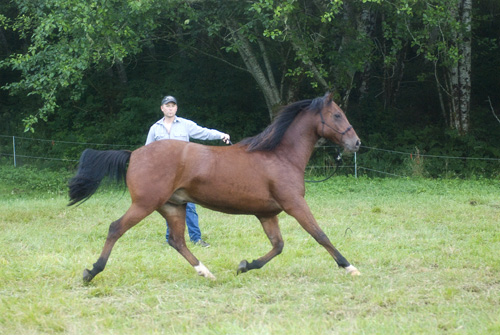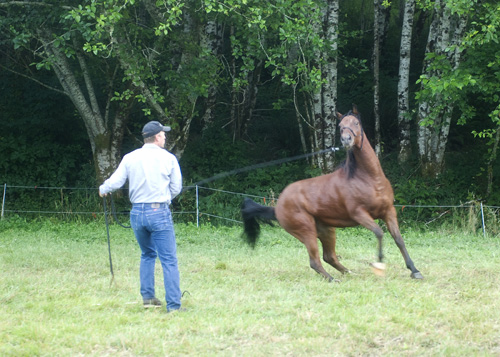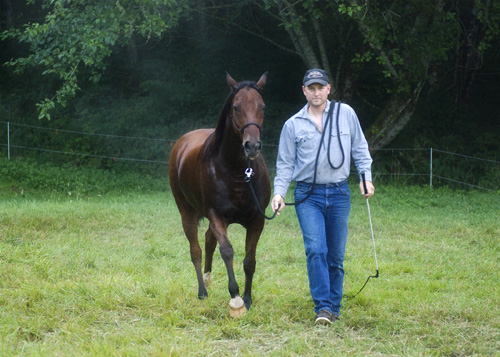 |
Quick Search |
 |
|
|
|
|
|
| Training A Horse To Lunge |

|
Prepare your horse by perfecting his leading and ground handling skills.
If a horse is not completely halterbroke and responsive to being led and handled,
you should not attempt to train the horse to lunge. Spend a lot of time with
your horse and practice basic leading skills until they are perfected.
The first few lessons will go easier if you have a helper. The ideal location
to begin lungeing is an indoor arena or open space that is far away from other horses
or distractions. Using a lungeing cavesson is the best option, but you can also use
a plain halter and long lunge line. You will also need a lunge whip.
To begin, attach your lunge line to the horse's halter, and keep the normal lead
rope attached as well, for your helper to use. The helper will stand beside the
horse's head in a normal leading position, and will stay behind the lunge line.
You will stand in the center of a large circle (50-60 feet in diameter). Hold
the lunge line in your left hand for a counter-clockwise circle, and the lunge
whip in your right hand. Ask the horse to walk with a voice command and raise
of the whip. (For vocal commands you can either say "walk" in a long low tone
or give a clucking "ck-ck" sound with your tongue. For the trot, use a medium
tone and more energetic command, or give another louder "ck-ck-ck" sound. For
the canter, say "canter" in a higher and very energetic tone, or make a kissing
sound with your lips.) The helper will lead the horse around the circle, at the
beginning, helping it to obey. You should stand in the center and just turn with
the horse.
Ask the horse to halt, using the voice command "whoa" and lowering the whip.
Your helper will make the horse stop and stand. You should go to the horse and
pat it and praise it; don't allow it to turn in and come to you, as it could develop
a bad habit of turning in often. Switch the lunge line, lead rope, and helper to
the other side of the horse, to go in the opposite direction. Return to the center,
hold the lunge line in your right hand and the whip in your left, and ask the horse
to circle in a clockwise direction.
You can advance to a trot from a walk by giving a voice command, swishing the whip
a little, and having the helper speed up. The horse should learn to stay at the
outside of the circle and listen for your commands. A lot of consistent practice
will help the horse develop good habits.
The helper can remove the extra lead rope and just continue to walk beside the horse.
Eventually, you will lunge the horse without a helper, but be prepared for the horse
to test you.
Some things your horse may attempt, and what you should do to prevent them:
Stopping when you haven't asked for a halt. Use the
lunge whip to swish,
snap, or flick to encourage the horse to move on. Do not allow the horse to
call the shots or you will lose control and respect. Make him continue to circle,
and if he refuses, swat him with the whip.
Speeding up when you haven't asked for a trot or canter.
Say "whoa" firmly and pull
the horse to a stop. Then resume walking. Do not allow the horse to go faster
than you have asked.

Bucking or goofing off while lungeing. This is
evidence of the horse having an abundance of energy, and you should ignore the
bucking and ask for a canter for several minutes until the horse settles down
and circles correctly at an even canter. Do not allow the horse to buck or rear
and then stop and stand still. Make him canter until he will straighten out and
canter correctly, then slow him down to a walk.
Cutting in on the circle, not staying to the outside.
Use the lunge whip and your advancing body language to move the horse back out of
the middle of the circle. Do not allow the horse to cut into the inside or he
will develop a bad habit. Be very watchful and if he starts to cut in, throw
your arms up high, swing the lunge whip at him to make him stay out.
Pulling strongly to the outside, not maintaining
a steady circle. You may have to switch to a rope halter that has knots where
the pressure points are on a horse's head if this persists. Or you can use a
bridle and snaffle bit. You can attach the lunge line to the snaffle bit by
running the snap end through the near side ring of the bit, up over the horse's
head alongside of the headstall, and clip to the bit ring on the off side. When
you change directions when lunging, you must unsnap the lunge line and thread it
through the opposite side of the bridle.
Things to avoid when lunging a horse:
Using too small of a circle, especially at faster gaits.
This can put too much stress on the hocks and leg joints of a horse and possibly
lame it.
Over-working a very young horse on the lunge line.
Horses under the age of three may have undeveloped joints or knees that haven't
"closed" yet. Asking a young horse to turn quickly or work too hard can permanently
injure its legs and joints. If training a young colt, keep things slow and relaxed,
and use as large a circle as possible.
Lunging a horse with an over-reaching stride without
bell boots and protective leg wraps to protect its legs and pasterns. It is
always good to use some type of leg protection when excercising a horse, but
if the horse tends to over-reach and strike the back of his front feet with his
hind feet, it is an absolute necessity to use bell boots and protective legwear.
Confusing the horse with unclear cues or voice commands.
You should form a V shape with your arms when lunging; one hand holding the lunge
line and "pointing" the direction the horse should go, and the other hand holding
the lunge whip and "following" the horse to encourage its movement around the circle.
Keep voice commands clear and always use the same ones.
Once you have clearly defined what the horse should do, then always follow through
and get the horse to obey. The horse will learn best if you ask consistently, expect
obedience, and then reward him.

More Horse Articles
|
|
|

